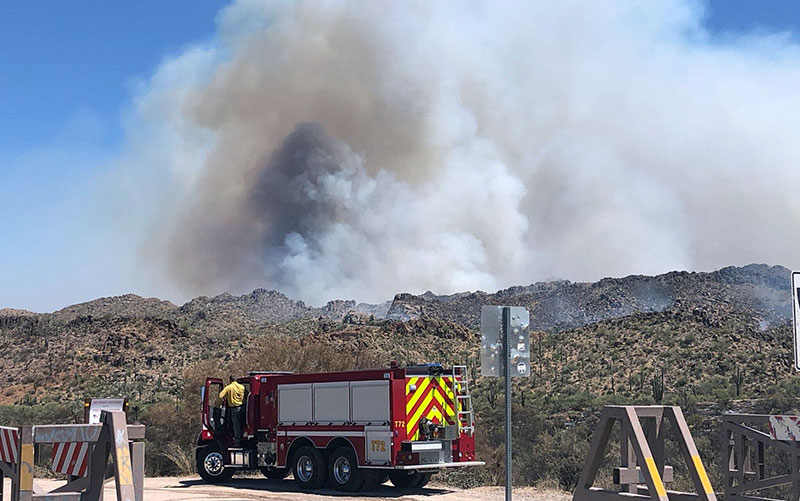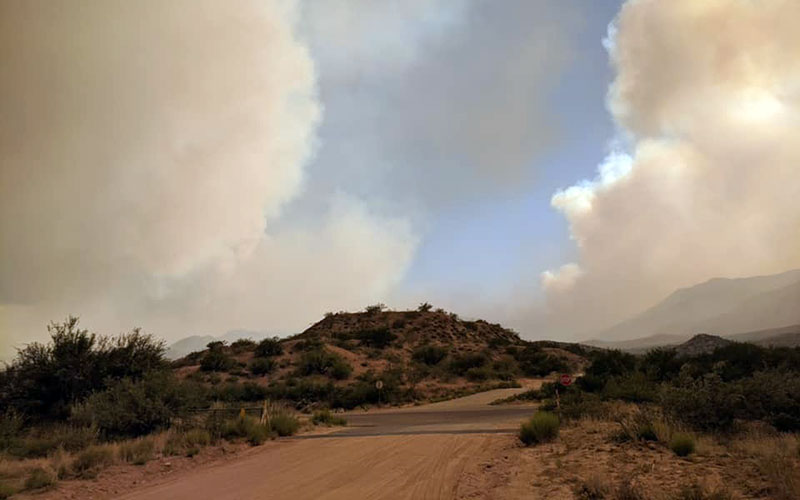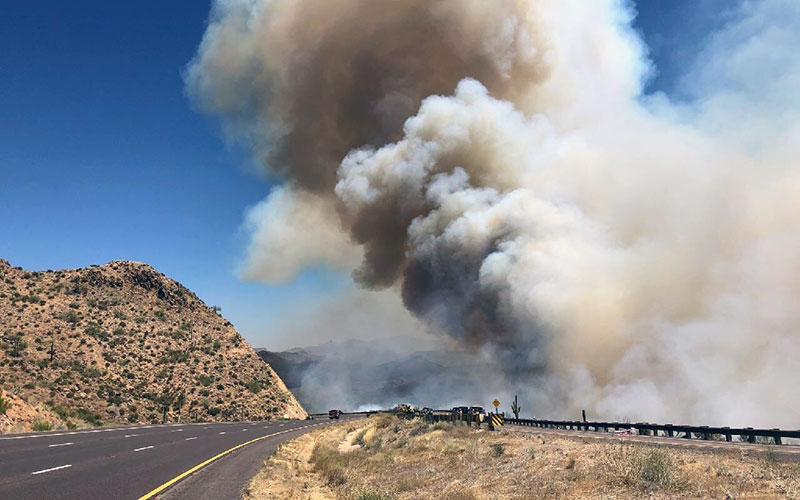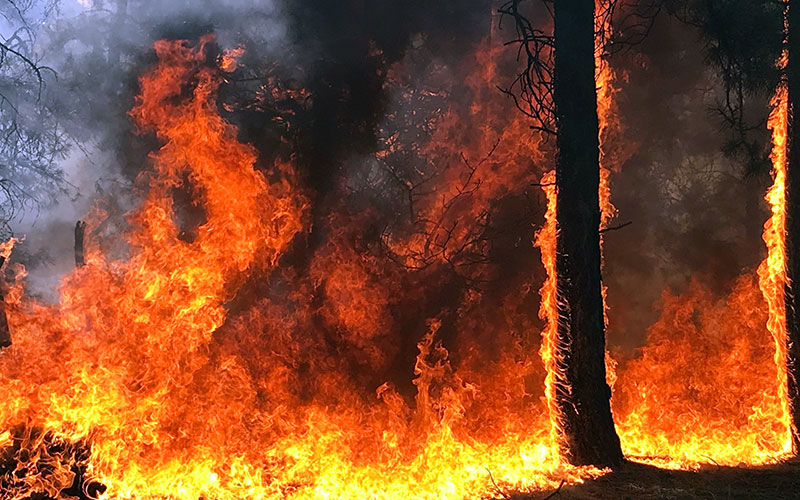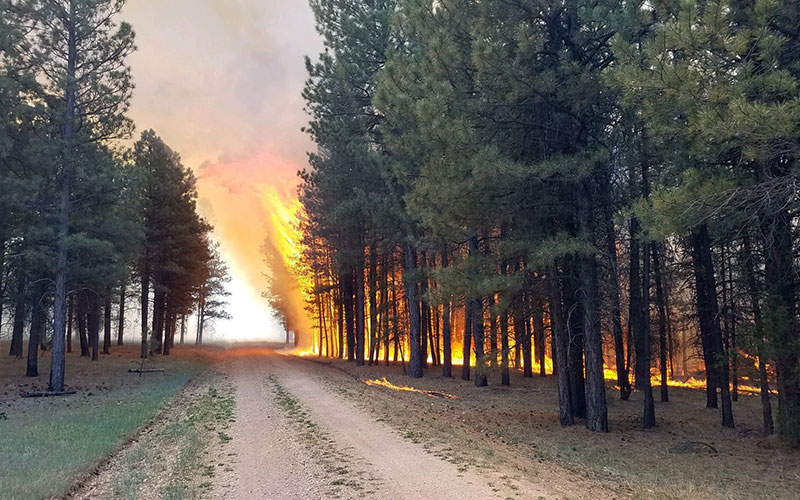PHOENIX — Nearly 1,500 people living west of Roosevelt Lake have been forced to evacuate because of the fast burning Bush Fire, which on Wednesday was the largest in the country at 89,059 acres, according to the National Interagency Coordination Center.
The wind-blown wildfire, which was ignited by a burning vehicle Saturday, was moving fast through tall grass and brush in a section of the Tonto National Forest about 40 miles northeast of Mesa. On Tuesday night, it crested the iconic Four Peaks.
“It’s just been a real wind-driven event,” said Dee Hines, a public information officer on the Bush Fire. “This time of year, at the height of fire season, the fields are very dry, and I really think the size is primarily due to the wind.”
Those conditions have set the stage for what’s already an above average fire year in Arizona. Wildfire experts said the state already has surpassed the number of fires during the same period last year. The Bush Fire, which has scorched 139 square miles and was only 5% contained Wednesday, was just one of 12 fires actively burning across the state.
View the expansion of the #BushFire northeast of #Phoenix via #VIIRS Day/Night Band nighttime imagery from 6/13 to 6/16. The #fire started on the afternoon of 6/13 and has burned nearly 40 acres. Explore 6/16 DNB via @UWSSEC RealEarth at https://t.co/uNZL8PTkzm #AZwx pic.twitter.com/UxQeDc5xYq
— UW-Madison CIMSS (@UWCIMSS) June 16, 2020
With another day of high winds and high temperatures expected Thursday, firefighters braced for the Bush Fire to continue to grow, pushing east toward State Route 188 and Roosevelt Lake. Evacuations began Tuesday night for parts of Gila and Maricopa counties, Inciweb reports. Residents of Apache Lake, Sunflower, Punkin Center and Tonto Basin were asked to evacuate Wednesday morning. Residents of Jake’s Corner were in pre-evacuation status Wednesday.
Many residents of those communities were evacuated last June to escape the Woodbury Fire, which took nearly two months to put out.
North of Tucson, firefighters were gaining some ground on the Bighorn Fire in the Catalina Mountains. A lightning strike June 5 ignited the fire, which has burned 17,000 acres in a rugged part of the Coronado National Forest. The blaze has forced hundreds of people to evacuate, and its previous estimated containment date has been extended from June 25 to July 4, according to the Arizona Daily Star.
The Bighorn Fire was estimated to be 40% contained on Wednesday, Inciweb reported. Weather conditions and wind have pushed the flames toward Summerhaven, near the summit of Mount Lemmon, where residents were being evacuated.
The Santa Catalina Ranger District has an extensive forest closure order in place for parts of the Coronado National Forest, including Romero Canyon, Pima Canyon and Finger Rock, according to Inciweb.
As of June 16, 941 wildfires – most of them human caused – were reported in Arizona in 2020, and nearly 170,000 acres of land have been burned, according to the state Department of Forestry and Fire Management. By this time last year, 689 fires had burned 47,000 acres.
Tiffany Davila of the forestry and fire management department said this is partly due to dry conditions and overgrown vegetation, as well as the sheer number of fires this year.
“They’re very erratic, they’re burning very hot and moving very fast,” she said.
Firefighting tactics can be ineffective because by the time crews arrive, the fire has grown 50 to 100 acres, Davila said, adding, “There’s a multitude of factors that we’re concerned about right now.”
More than 95% of fires in Arizona this year were started by people. Davila said there are many steps people can take to help fight the increase in fire activity this season.
“We work throughout the year to do fuels-mitigation work to do prescribed burning to help alleviate it to decrease that risk,” she said. “But we need the public to help us out and create that defensible space around their property and build that buffer zone between their property and a potential wildfire.”
Here’s how you can help prevent wildfires in Arizona
- Obey fire restrictions
- No target shooting or fireworks on state lands at any time
- Avoid burning on windy days
- Avoid using equipment that throws sparks
- Check tow chains when on the road
- Avoid pulling off the road into tall grass
Fire season peaks in June and July across the Southwest, according to the National Significant Wildland Fire Potential Outlook, which predicts a higher than normal potential for fires this summer. Fire experts predict drier conditions for early July, with some relief expected by the end of the month if the monsoon season arrives.
The largest wildfires burning in Arizona as of June 17, according to Inciweb.
Mangum Fire
- 47,561 acres
- Kaibab National Forest, 24 miles southeast of Fredonia
- Started June 8
- 3% contained
- Cause unknown
Blue River Fire
- 30,400 acres
- San Carlos Agency of the Bureau of Indian Affairs, 8 miles northeast of San Carlos
- Started June 5
- 85% contained
- Caused by lightning
Bush Fire
- 89,059 acres
- Tonto National Forest, 38 miles northeast of Mesa
- Started June 13
- 5% contained
- Caused by a vehicle fire
Bighorn Fire
- 17,492 acres
- Coronado National Forest, 3 miles southeast of Oro Valley
- Started on June 5
- 40% contained
- Caused by lightning
- 3 minor heat-related injuries reported

